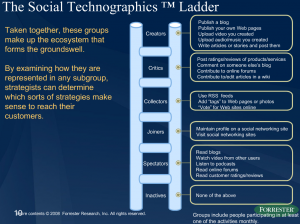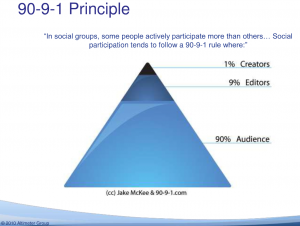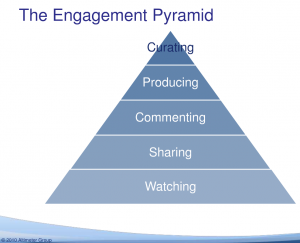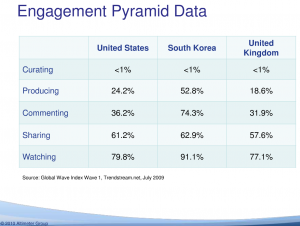Yearly Archives: 2010
Duping by the crowd vs. building community among neighbors
Greg Sterling blogged today (in part)…
The Sunday Times in the UK writes that Yell employees wrote 6,700 reviews for the site (TrustedPlaces) in a month for an internal contest. According to secondary reports:
Staff at the firm’s Reading HQ were encouraged to write reviews for the company’s website Trusted Places – a site boasting user-generated recommendations of places to visit – by the offer of prizes such as an iPad and Amazon vouchers, according to the Sunday Times.
The article and information are presented as something of an expose or scandal. However I don’t necessarily agree. If the reviews are real and authentic they’re not illegitimate in my mind. But it’s a close call…
Well… I’m not sure how 6,700 reviews written by paid staff for some kind of internal contest could be considered “real and authentic.” More importantly, this fuels a not uncommon suspicion that many online reviews are B.S. It’s just too easy to stack the deck with reviews from people who have a stake in the business being reviewed or in the host site itself.
We often hear from people who place a high value on reviews read on Front Porch Forum. They use terms like “real” and “authentic” because that’s what they are… postings from clearly identified nearby neighbors typically offered in response to a request from a neighbor… “can anyone recommend a good plumber?”
Also, each recommendation is seen by everyone in the neighborhood, not just those few who happen to be searching for a plumber. This leads to conversation among neighbors… sometimes on FPF, often via email, and even more commonly face-to-face.
So… a huge database of potentially bogus reviews from strangers… vs. a few reviews from clearly identified nearby neighbors that lead to conversations among neighbors on the sidewalk. Two different propositions.
Feelings lead to action
Richard Millington’s post today got me thinking…
Feelings provoke actions… Focus on making members feel more engaged, not act more engaged.
Many times a day, Front Porch Forum pilot members are moved to be more engaged in FPF… and, more importantly, many are move to be more engaged in their actual/non-virtual neighborhood. This is often brought about by feelings elicited by an FPF posting from a neighbor.
Here are two key references from Millington…
You’ve probably come across the technographics ladder or the socialgraphics engagement pyramid. These categorize members by their actions. Lurkers are at the bottom, creators at the top. Sharing, reading, tagging are in-between.
First, the technographics ladder…

And the socialgraphics engagement pyramid…



Mark Suster on Social Networking
Entrepreneur and venture capitalist Mark Suster open his blog post today with …
What I want to answer with this post (long though it may be) is:
- Why did Web 2.0 emerge and are there any lessons to be gained about the future? [cheap accessible digital hardware]
- Why did Twitter emerge despite Facebook’s dominance? [asymmetry, real-time, curated RSS / link-sharing]
- Why did MySpace lose to Facebook & what can Twitter learn from this? [encouraging an open platform where 3rd parties can make lots of money]
- Does Facebook have a permanent dominance of the future given their 500m users? [chuckle. ask microsoft, aol/time warner & google]
- What are the big trends that will drive the next phase of social networks? [mobile, locations, layering of services, data management, portability & more]
An excellent piece… worth the whole read. Shortened version here… and full version here.
Our mutual aid muscles are out of shape and pretty flabby
From Sarah Byrnes in YES! Magazine…
If there’s anything I’ve learned while helping to organize Common Security Clubs in communities around the nation, it’s that there is no “one size fits all” club. They are as different as the individuals who comprise them.
But a common thread is that clubs provide a way for people get to know each other. It’s an old-fashioned concept—knowing your community—but it’s badly needed in our time of increasing insecurity and isolation.
“We usually spend about 45 minutes on a ‘check-in’ with each other,” says Paul Miller in Boston, whose club has been meeting for two years. “The focus is simply on hearing each other, and providing support whenever possible. People get to air their concerns and receive affirmation.”
“We’re taking baby steps toward a new type of community,” adds Jared Gardner, a facilitator in Portland, Oregon. “We want people to feel connected and empowered. That’s what the groups are all about.”
In the past, neighbors knew each other and engaged more naturally in mutual aid, sharing common resources and helping those in need. Nowadays, our mutual aid muscles are out of shape and pretty flabby. Clubs help us to start flexing and stretching them again, little by little.
New study: Neighborhood websites build community and get people involved
Congratulations to UK’s Hugh Flouch and Kevin Harris on the publication of the results of their new study…
Do neighbourhood websites have a positive social impact locally? For those who’ve suspected and long wanted convincing evidence, we think the wait is over.
The report of the Online neighbourhood networks study was launched yesterday during a lively conference in London…
Our study looked at three neighbourhood sites in London. The research shows that they serve to enhance the sense of belonging, democratic influence, neighbourliness and involvement in their area. Participants claim more positive attitudes towards public agencies where representatives of those agencies are engaging online.
We’ve produced a short (4-page) summary, an extended summary, a full report divided into digestible chunks, a selection of video interviews, together a number of other papers, and we will continue to add to these.
We see similar trends with Front Porch Forum in our pilot region. That is, FPF members report… (1) better connection to neighbors and neighborhood, (2) a more prominent voice in local decision-making, (3) a friendlier environment, and (4) increased civic engagement.
Miscellaneous findings from the UK report…
95% – Feel more informed about neighborhood
92% – Neighbors are helpful if asked for advice
69% – Increased sense of belonging within neighborhood
92% – Useful information gets shared efficiently
82% – People pull together to improve neighborhood
63% – Main source of local news
44% – Neighbors more likely to lend items or exchange favors
42% – Met a neighbor
54% – More likely to see a neighbor you recognize due to website – Active member
14% – More likely to see a neighbor you recognize due to website – Passive member
This collection of materials is worth a close look!
Where do social enterprises fit on the spectrum of organizations?
Front Porch Forum is a mission-drive for-profit business located in Vermont. Once a year, we ask our tens of thousands of member households to consider chipping in $10 to $100 as a contribution to help us maintain, improve and expand FPF. This is strictly voluntary… FPF is a free service. It’s also not a charitable contribution, nor is it tax deductible.
This puts FPF in a position unfamiliar to many… “is FPF a charity or a business?” We’ve heard that more than once. We know that the economy and world are more complex than that. That’s why this graphic found today on Working Wikily appeals to me. It’s from Canada’s Social Innovation Generation‘s Task Force on Social Finance report: Mobilizing Private Capital for Public Good.

I’d say FPF is in the “social purpose business” to “socially responsible business” range.
How many needed to make community planning successful?
Bill Roper asks today “What constitutes successful participation in your community”…
Over the years, we at the Orton Family Foundation have debated how much citizen participation constitutes success in our projects. This discussion gets complicated as the “how many” quickly and appropriately gives way to a deeper conversation about the “who” in the room and the opportunity and level of participation rather than just a simple head count…
As I often say, the only thing harder than planning in the midst of a crisis is planning without a crisis at all. So: when there is no crisis at hand and a community is trying to bring citizens together for authentic, thoughtful discussions about its future, what constitutes a successful turnout? From my observations, achieving 10 percent community participation is pretty amazing (even though it doesn’t sound so great). And if this happens two or three times in a row, there’s really something going on.
Another way I’ve tried to calculate success in the numbers is to find out how many people turned out for the most controversial issue in the last five years, (i. e. a development proposal, school bond, crime, etc.). If the community then meets or exceeds that number in the context of a proactive planning discussion, that equals success.
But I’m still not satisfied. This may be setting the bar too low.
In dozens of Vermont towns and neighborhoods, more than 40% of the households subscribe to Front Porch Forum, where planning-relevant discussion often occurs. In one town that we studied, about three-quarters had posted in the first year.
Of course, ongoing online exchange among neighbors is different than face-to-face planning sessions, but we have seen many times where community turnout swells for such gatherings once FPF is up and running well. Frequent communication among clearly identified nearby neighbors gets folks informed and engaged.
How best to attract neighbors to online community?
From Richard Millington at FeverBee…
Which of these communities would you most like to join?
- An online community for local residents to participate in the public consultation process and have their say on everything from planning permission, budget allocation and
- An exclusive online community for local residents to prove their knowledge and share top tips on which local services to trust, best places to eat/shop and trade goods.
- An exclusive online community to learn the latest gossip about your neighbours and discover who’s hot or not in your local community.
Most councils/local government authorities will say the first.
Most residents say the second option works best.
Most people would actually join the gossip community.
You can treat this as a dismal reflection of modern society or as a great opportunity. Increasingly I suspect the key to developing a successful local community (or any community) is to begin with the gossip, move on to offer value and then aim for engagement on matters that affect the entire community.
Vermont Citizens in a Connected Age Workshop Dec. 11
The Citizens in a Connected Age workshop advances the computer and Internet skills learned through the Vermont State Colleges and Vermont Small Business Development Center courses offered in each e-Vermont project town.
However, ANY Vermonter with basic computer skills can attend this workshop!
Learn About
- Website communication tools.
- Social media – strategies for incorporating it into a business, government or personal life, with computer lab time.
- Troubleshooting technology – how to diagnose a problem with applications.
- Data security – backing up data, protecting private information.
- Marketing a business online.
- Google applications – why use Google apps, with computer lab time.
- Weighing the risks and benefits of online financial transactions.
- Digital storytelling for educators.
- Best practices for e-government websites.
When and Where
- Saturday, December 11, 2010
- 9:00 a.m. to 4:00 p.m.
- Castleton State College, Castleton, Vermont
- $10 registration fee – includes course offerings, refreshments and lunch.
- Options for online registration: pay by credit card online, or register online and pay at the door. We cannot accept credit cards at the workshop.
- Download the workshop poster (pdf).
For more information
Contact Joanna Cummings, e-Vermont Community Coordinator: joanna@snellingcenter.org
Visit
- The e-Vermont Community Broadband Project website: http://e4vt.org
- The Snelling Center’s e-Vermont website: http://www.snellingcenter.org/public-policy/e-vermont
About Blog
Ghost of Midnight is an online journal about fostering community within neighborhoods, with a special focus on Front Porch Forum (FPF). My wife, Valerie, and I founded FPF in 2006... read more
Post Categories
- Uncategorized
- PDF2009
- Calendar
- Northeast Kingdom
- podcast
- Peer Rental
- Localization
- Big Tech
- Events
- PDF2007
- Web Traffic
- Google AdSense
- Pay It Forward
- Elections
- berkmansunlight
- Maps
- Video
- Upstate New York
- Coupons
- Wildlife
- Mobile
- Viral Marketing
- Raffle
- Crisis Response
- Donations
- Lost & Found
- Real Estate
- College Students
- Gratitude
- Social Responsibility
- Orton Family Foundation
- Start ups
- Make It Your Own Awards
- Online Civility
- Clay Shirky
- Newspapers
- Humor
- How To Use FPF
- Best of FPF
- Online Classified Ads
- Peer Reviews
- Politics
- Community Management
- Economic Development
- Local Reviews
- Case Foundation
- Borrow and Lend
- Neighborhood Watch
- Good Government
- Small Business Advertising
- Citizen Journalism
- e-Vermont
- Democracy
- Local Search
- Knight Foundation
- Burlington
- MacArthur Fellows
- Civic Engagement
- Social Media
- social capital
- Social Networking
- Vermont
- Neighborhood
- Community Building
- Local Online
- Front Porch Forum